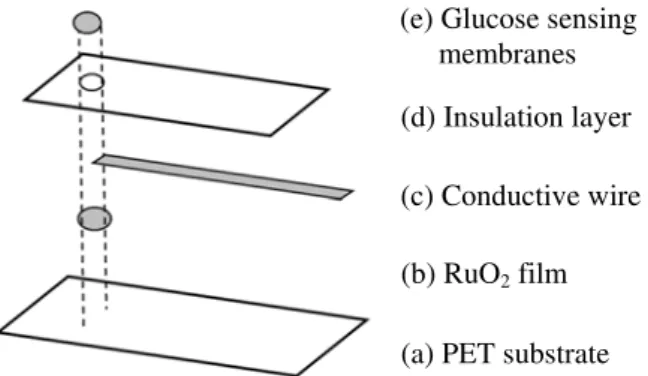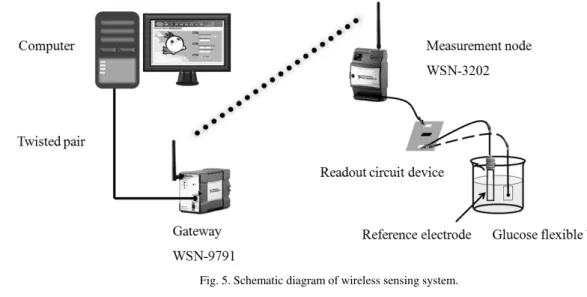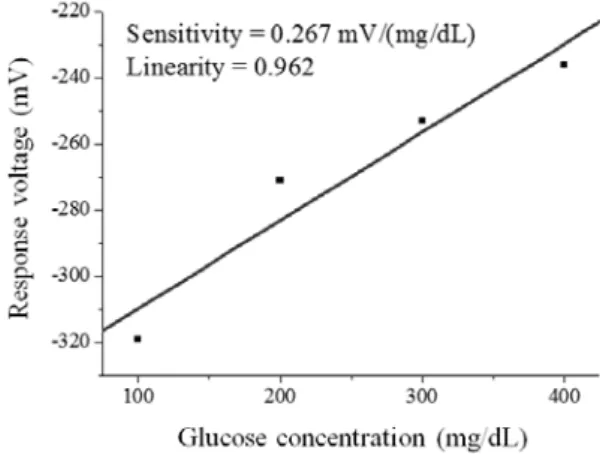Abstract—In this study, the wireless sensor network (WSN) with Zigbee technique was integrated with the glucose flexible biosensor. The wireless sensing system was accomplished by the graphical language laboratory virtual instrumentation engineering workbench (LabVIEW). The wireless sensing system can be classified into two parts, which are the glucose detection system of front end and transmission platform of back end. The glucose detection system embraces ruthenium dioxide polyethylene terephthalate (RuO2/PET) biosensor, silver/silver chloride (Ag/AgCl) reference electrode and readout circuit device. The transmission platform was transmitted the detection signals in real-time, which displayed the results in the computer. In addition, the wireless sensing system was used to detect glucose values in different concentrations of glucose solutions.
Index Terms—Wireless-sensor-network, glucose, biosensor, LabVIEW, real-time
I. INTRODUCTION
HE wireless sensor network (WSN) was consisted of network nodes with sensor, that designed to communicate via wireless radio. The recent development of wireless sensor network provided the advantages of low cost, low power consumption, small size, flexibility and distributed intelligence that compared with wired ones [1]. The sensors were combined with the WSN that has been widely used in various applications. The applications of WSN techniques have been proposed in the healthcare of patient monitoring [2, 3]. The monitored signals include heart
Manuscript received March 6, 2013. This study has been supported by National Science Council, Republic of China, under the contracts NSC 100-2221-E-224-017, NSC 101-2221-E-224-046 and NSC 101-2221-E-265-001.
Jie-Ting Chen is with the Graduate School of Electronic and Optoelectronic Engineering, National Yunlin University of Science and Technology, Douliou, Taiwan 64002, R.O.C. (e-mail: m10013337@yuntech.edu.tw).
Jung-Chuan Chou is with the Graduate School of Electronic and Optoelectronic Engineering, National Yunlin University of Science and Technology, Douliou, Taiwan 64002, R.O.C. (phone: (8865)5342601 ext.4333; fax: (8865)5312063; e-mail: choujc@yuntech.edu.tw).
Yi-Hung Liao is with the Department of Information Management, TransWorld University, Douliou, Taiwan 64002, R.O.C. (e-mail: liaoih@twu.edu.tw).
Hsueh-Tao Chou is with the Graduate School of Electronic and Optoelectronic Engineering, National Yunlin University of Science and Technology, Douliou, Taiwan 64002, R.O.C. (e-mail: chouht@yuntech.edu.tw).
Chin-Yi Lin is with the Graduate School of Electronic and Optoelectronic Engineering, National Yunlin University of Science and Technology, Douliou, Taiwan 64002, R.O.C. (e-mail: m10113316@yuntech.edu.tw).
Jia-Liang Chen is with the Department of Electronic Engineering, National Yunlin University of Science and Technology, Douliou, Taiwan 64002, R.O.C. (e-mail: u9913022@yuntech.edu.tw).
rate (HR) electrocardiogram (ECG), blood glucose, activity for ambulatory health monitoring. Environment monitoring [4, 5] has become an important area of management and protection that provided real-time system and control communication from WSN. In literature [6], a wearable healthcare system was integrated with WSN for detecting falls of an elder person the healthcare system can reduce the cost of medical care, and improves primary care services. About the application of intelligent life was proposed in literature [7]. This literature was developed a smart medication system which utilized the WSN techniques. The functions of medication system are medication reminding, pill-dispensing assisting and medication recording.
In 1970, P. Bergveld [8] presented a chemical sensor, ion sensitive field effect transistor (ISFET), that was fabricated by semiconducting process and electrochemistry technique. The physical difference in the ISFET structure is to replace the metal gate of the metal-oxide-semiconductor field effect transistor (MOSFET) by the series combination of the reference electrode, electrolyte and chemical sensitive insulator or membrane [9]. Afterward, Spiegel et al. [10] proposed the extended gate ions sensitive field effect transistor (EGISFET) in 1983. The EGISFET was improved to become separative extended gate field effect transistor (SEGFET) [11]. The SEGFET structure only needs to change sensing electrode, and the MOSFET device of that can be used repeatedly. The structure is shown in Fig. 1 [12]. The SEGFET holds the advantages of small size and fast response time. An extended metal wire is used as the connection between metal gate and field effect transistor (FET), and the sensing film is deposited on the metal gate area to measure the various detections of environment.
We achieved the WSN integrated with the glucose flexible biosensor, and detected in different concentrations of glucose solutions. Some advantages of the WSN are presented a low cost technique for collecting detection signals, the cable cost and space expansion can be increased. Consequently, the WSN for homecare, healthcare, and environmental monitoring in our life is required. The proposed system includes the glucose detection system and transmission platform.
Fig. 1. Structure of SEGFET [12].
Integration of the Real-Time Remote Wireless
Sensing System for Glucose Flexible Biosensor
Jie-Ting Chen, Jung-Chuan Chou*, Yi-Hung Liao, Hsueh-Tao Chou, Chin-Yi Lin, and Jia-Liang Chen
II. EXPERIMENTAL
A. Glucose Detection System
Potentiometric electrochemical method was used to measure the output signal of the potential difference between reference electrode and glucose flexible biosensor. This glucose detection system comprises: test solutions in the container; a silver/silver chloride (Ag/AgCl) reference electrode providing stable reference potential in test solutions; a glucose flexible biosensor; a readout circuit device amplifying the detection signals.
The glucose flexible biosensor was imitated the structure of SEGFET and a 99.99% purity ruthenium metal target via radio frequency (R.F.) sputtering was used, which deposited ruthenium dioxide (RuO2) thin film on PET substrate. The sensing membrane has an area of 3 mm × 3 mm. The screen printing technique produced conductive wire and insulation layer. The insulating layer has an aperture for exposing a sensing window on the biosensor. The glucose sensing membrane was prepared by a optimal mixed ratio of 3:4 (wt%) with Nafion and glucose oxidase (GOX) [13]. The cross-sectional of glucose flexible biosensor was shown in Fig. 2 [14].
Fig. 2. Glucose flexible biosensor cross-sectional view [14].
The commercial instrumentation amplifier (LT1167 CN8, LINEAR TECHNOLOGY) was regarded to the appropriate component of readout circuit device. The LT1167 is a low power, precision instrumentation amplifier that requires only one external resistor to set gains of 1 to 10,000. The block diagram of the instrumentation amplifier was shown in Fig. 3. Compared with Fig. 4, the description of the input and output pins was as follows. The second pin (-IN) of LT1167 was connected with glucose flexible biosensor. The reference electrode was connected to ground at the third pin (+IN). The fifth pin (REF) grounded. Furthermore, the detection signal was calculated by instrumentation amplifier and transmitted to the wireless measurement devices at the sixth pin (OUTPUT). The power supply of instrument amplifier needs to supply ±5V at the seventh pin (+VS) and the fourth pin (-VS). The others were not connected.
B. Transmission Platform
The transmission platform was consisted of wireless measurement devices and graphical language. The popular near field communications are such as Zigbee, Bluetooth, and Wi-Fi. In this study, the wireless measurement device used
transmit the detection signals. Wireless measurement device consists of the measurement node (Model: NI WSN-3202, National Instruments Corp., U.S.A.), and a gateway (Model: NI WSN-9791, National Instruments Corp., U.S.A.). The measurement nodes had directly connected via 2.4 GHz radio transmitted signals to the gateway. Measurement node installed with four 1.5 V AA alkaline battery cells. Each measurement node offers four analog input channels and four digital Input/Output channels. The gateway must be connected to a host controller running graphical language (Model: LabVIEW 2011, National Instruments Corp., U.S.A.) that can process, analyze, and display detection signals. The wireless sensing system is shown in Fig. 5. The transmission distance of a single measurement node indoor is about 10 meters to 15 meters.
Fig. 3. Block diagram of the instrumentation amplifier.
Fig. 4. Top view of the instrumentation amplifier.
C. Description of Graphical Language
The LabVIEW used a kind of program language: graphical language. The graphical language is a method of graphic designed to replace the traditional text program function. This study used the graphical language LabVIEW to implement the real-time remote wireless sensing system, and the main functions were described below. Before running graphical language LabVIEW, the wireless measurement devices should be installed.
At first, we describe the gateway operation in program. As shown in Fig. 6, the ‘WSN Open Gateway’ creates a reference to the gateway. User can confirm the gateway internet protocol (IP) address is correct, and then the ‘WSN Discover All Nodes’ was started to search the measurement nodes via the WSN network. ‘WSN Get Node Info’ was returned information about the specified measurement node. Finally, the program was set parameter and scanned amount (a) PET substrate
(b) RuO2 film (c) Conductive wire (d) Insulation layer (e) Glucose sensing
Fig. 5. Schematic diagram of wireless sensing system.
Fig. 6. Program framework of gateway interface.
If the measurement node were working normally that should create the shared variable node. The shared variable node represents to transmit information between different virtual instruments. As shown in Fig. 7, the analog inputs (AI0-AI3) are the shared variable nodes relative to the four analog channels of measurement node. The ‘WSN Open Node Reference’ creates a reference to the specified measurement node, and then closes the reference. The collection information will output to the next step.
Fig. 7. Program framework of measurement node interface.
Next all functions are processed the detection signals. The descriptive programs of storage and display framework are shown in Fig. 8. In Fig. 8 (a), the function is referred to select saving path. In addition, after terminating the measurement, the program will automatically save two files: an excel files of measured data (*.xls) and a graph (*.png). In Fig. 8 (b), the function of ‘Waveform Chart’ can display the result of measurement with real-time which will be written into selected saving path file. The saving path is retained in the beginning, which provides a function to auto-save the completed measurement curve for the ‘*.png’ formation.
(a)
(b)
Fig. 8. Program framework of (a) storage interface and (b) display interface.
III. RESULTS AND DISCUSSION
In this study, we built the glucose detection system to detect glucose value, and integrated with the wireless sensor network, transmitted signals with real-time and displayed the results. The glucose flexible biosensor was based on RuO2/PET. The glucose detection system was measured in glucose solutions (100 mg/dL, 200 mg/dL, 300 mg/dL, and 400 mg/dL). The environment temperature was controlled at room temperature (25℃). The immovable measurement time was set 180 seconds. If the measurement time needs to change, the parameter settings can be changed in the user interface.
Fig. 9. Diagram of measurement results of glucose flexible biosensor.
Different sensing films and characteristic of glucose biosensors were compared with other literatures [15, 16]. J. C. Chou et al. [15] reported that the sensitivity and linearity of ruthenium oxide based glucose biosensor are 0.018 mV(mg/dL)-1 and 0.964, respectively. This literature had bad sensing characteristics because the ruthenium metal thin film had smooth surface, which is not easy to adhere enzyme. S. R. Lee et al. [16] proposed that the glucose biosensor was fabricated by utilizing silicon nitride (Si3N4)-based on ISFET, although the glucose biosensor had a wide detecting range (0-1800 mg/dL), but it had lower sensitivity (0.05 mV(mg/dL)-1). Besides, the structure of ISFET had the disadvantages such as high cost, complicated process, not easy to package, etc. that compared with the structure of SEGFET.
TABLE I
GLUCOSE BIOSENSOR IN THIS STUDY IS COMPARED WITH OTHER
LITERATURES
Sensing membrane/ Substrate
Sensitivity
(mV(mg/dL)-1) Linearity
Linear range (mg/dL)
Ref. RuO2/PET 0.267 0.962 100-400
In this study RuO2/ Silicon 0.018 0.964 100-500 [15]
Si3N4 / Silicon
nitride 0.050 0.989 0-1800 [16]
Different WSN techniques and sensor analytical apparatus were presented in literatures [17, 18]. We compared the properties of literatures [17, 18] and were shown in Table II. The WSN system of literature [17] was based on graphical language LabVIEW with the Bluetooth wireless technique for handheld devices. But the measurement system was limited to extend more sensor devices. In this study, the measurement node had four channels, and the 16 bits A/D resolution of NI WSN system can process more signal transfer quickly. However, a measurement node offered four analog input channels. If we expected to extend more channels to transmit analog signals, we just needed to add another node to install in NI WSN system. In addition, the analytical apparatus of graphical language LabVIEW is the simpler and more flexible than literature [18]. The graphical language LabVIEW is easily customized and controlled with
TABLE II
WSNSYSTEM IN THIS STUDY IS COMPARED WITH OTHER LITERATURES
Method of transmission
A/D resolution
Analytical
apparatus Application Ref. Zigbee,
Twisted pair 16 bits LabVIEW Glucose
In this study Bluetooth,
RS-232 10 bits LabVIEW
pH, Potassium, Sodium, Chloride [17] 2.4GHz wireless transceiver, RS-232
8 bits ASCII pH, Temperature, Chlorine
[18]
We presented a wireless sensing system based on the transmission platform. The wireless sensing system received the detection signals and analyzed the characteristic of biosensor.
IV. CONCLUSION
In this study, the wireless sensing system has been successfully prepared for detecting glucose value. The system was integrated with glucose detection system and transmission platform. The system provides a real-time monitoring and rapid detection, and the detection range from 100 mg/dL to 400 mg/dL with sensitivity 0.267 mV(mg/dL)-1, linearity 0.962. Moreover, the wireless sensing system was designed by using graphical language LabVIEW which can design different functions according to user’s needs. In the future, this system can be developed in the applications of other sensors or biosensors and be applied to healthcare at home, provides user with better quality of life and better health in a cost effective manner.
REFERENCES
[1] L. R. Garcia, P. Barreiro, and J. I. Robla, “Performance of ZigBee-based wireless sensor nodes for real-time monitoring of fruit logistics,” J. Food Eng., vol. 87, pp. 405-415, Aug. 2008.
[2] H. J. Lee, S. H. Lee, K. S. Ha, H. C. Jang, W. Y. Chung, J. Y. Kim, Y. S. Chang, and D. H. Yoo, “Ubiquitous healthcare service using zigbee and mobile phone for elderly patients,” Int. J. Med. Informatics, vol. 78, pp. 193-198, Mar. 2009.
[3] A. Milenkovic, C. Otto, and E. Jovanov, “Wireless sensor networks for personal health monitoring: issues and an implementation,” Comput.
Commun., vol. 29, pp. 2521-2533, Aug. 2006.
[4] M. F. Othman and K. Shazali, “Wireless sensor network applications: a study in environment monitoring system,” International Symposium on
Robotics and Intelligent Sensors, Sarawak, Malaysia, 2012, pp.
1204-1210.
[5] W. S. Jang, W. M. Healy, and M. J. Skibniewski, “Wireless sensor networks as part of a web-based building environmental monitoring system,” Autom. Constr., vol. 17, pp. 729-736, Aug. 2008.
[6] R. Paoli, F. J. Fernández-Luque, G. Doménech, F. Martínez, J. Zapata, and R. Ruiz, “A system for ubiquitous fall monitoring at home via a wireless sensor network and a wearable mote,” Expert Syst. Appl., vol. 39, pp. 5566-5575, Apr. 2012.
[7] W. W. Chang, T. J. Sung, H. W. Huang, W. C. Hsu, C. W. Kuo, J. J. Chang, Y. T. Hou, Y. C. Lan, W. C. Kuo, Y. Y. Lin, and Y. J. Yang, “A smart medication system using wireless sensor network technologies,”
Sens. Actuators, A, vol. 172, pp. 315-321, Dec. 2011.
[8] P. Bergveld, “Development of an ion-sensitive solid-state device for neurophysiological measurements,” IEEE Trans. Biomed. Eng., vol. BME-17, pp. 70-71, Jan. 1970.
[9] S. Swaminathan, S. M. Krishnan, L. W. Khiang, Z. Ahamed, and G. Chiang, “Microsensor characterization in an integrated blood gas measurement system,” Proceedings of IEEE Asia Pacific Conference
[11] J. C. Chou and J. M. Chen, “An equivalent circuit model for simulating the separative extended gate field effect transistor,” Sens. Lett., vol. 6, pp. 924-928, Dec. 2008.
[12] L. L. Chi, J. C. Chou, W. Y. Chung, T. P. Sun, and S. K. Hsiung, “Study on extended gate field effect transistor with tin oxide sensing membrane,” Mater. Chem. Phys., vol. 63, pp. 19-23, Feb. 2000. [13] T. Y. Cheng , J. C. Chou, G. C. Ye, and C. C. Chen, “Fabrication of
arrayed glucose biosensor based on microfluidic framework,”
Proceedings of The 6th Asia-Pacific Conference on Transducers and
Micro/Nano Technologies, Nanjing, China, 2012.
[14] J. C. Chou, W. C. Chen, and C. C. Chen, “Flexible sensor array with programmable measurement system,” Proceedings of International
Conference on Chemical and Biomolecular Engineering, Japan, 2009,
pp. 340-344.
[15] J. C. Chou and H. Y. Yang, “Potentiometric glucose biosensor based on ruthenium-modified RuO2/Si sensing electrod,” The 8th Asian
Conference on Chemical Sensors, Daegu, Korea, 2009, pp. 11-14.
[16] S. R. Lee, K. Sawada, H. Takao, and M. Ishida, “An enhanced glucose biosensor using charge transfer techniques,” Biosens. Bioelectron., vol. 24, pp. 650-656, Dec. 2008.
[17] J. F. Cheng, J. C. Chou, T. P. Sun, S. K. Hsiung, and H. L. Kao, “Study on a multi-ions sensing system for monitoring of blood electrolytes with wireless home-care system,” IEEE Sens. J., Vol. 12, pp. 967-977, May, 2012.
[18] W. Y. Chung, C. L. Chen, and J. B. Chen, “Design and implementation of low power wireless sensor system for water quality monitoring,”
Proceedings of The 5th International Conference on Bioinformatics and
![Fig. 1. Structure of SEGFET [12].](https://thumb-eu.123doks.com/thumbv2/123dok_br/18177987.330747/1.892.500.784.1029.1158/fig-structure-of-segfet.webp)


